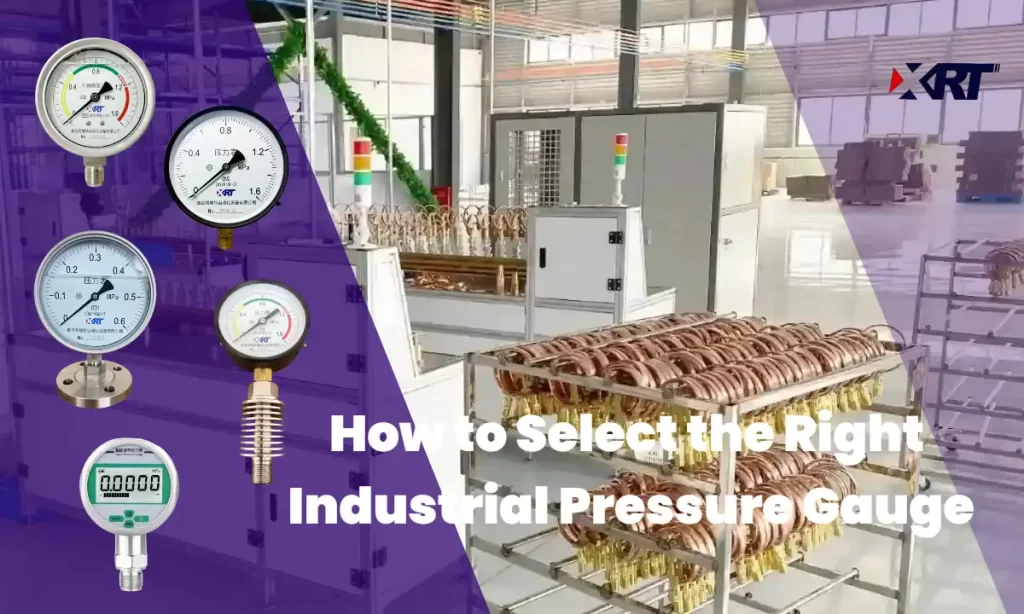Why is selecting the right pressure gauge important?
Industrial pressure gauges play a crucial role in modern industrial production, equipment monitoring, and safety control. According to market research, the global industrial pressure measurement market is expected to exceed $5 billion by 2027. In regions like the Middle East, Southeast Asia, and Central Asia, the demand for high-quality pressure gauges is growing due to the expansion of manufacturing, energy, and petrochemical industries.
As a leading manufacturer of pressure and temperature instruments in China, XRT is dedicated to providing high-precision, durable pressure measurement solutions to ensure equipment stability, reduce maintenance costs, and enhance operational safety. Choosing the right pressure gauge is essential for improving measurement accuracy, extending service life, and preventing potential hazards caused by inaccurate pressure readings.
With years of experience as a pressure gauge supplier in international markets, we understand that different regions and industries require tailored solutions to handle various working conditions, such as high temperatures, corrosive environments, and fluctuating pressures. In the following sections, we will outline the key factors to consider when selecting the ideal pressure gauge.
Overview of Different Types of Industrial Pressure Gauges
Key Features & Advantages:
- Pressure Range: 0.6 MPa to 160 MPa (varies by material and design)
- Accuracy: ±0.1% to ±2.5% (depending on application)
- Medium Compatibility: Suitable for measuring liquids and gases, including air, steam, and hydraulic systems
- Material Options: Available in stainless steel and brass construction for varying environmental conditions
- Oil & Gas Industry: Monitoring pipeline and storage tank pressures
- Petrochemical & Power Plants: Stable pressure control in boilers and turbines
- Manufacturing & Machinery: Reliable pressure readings in hydraulic and pneumatic systems

2. Bellows Pressure Gauge
A bellows pressure gauge uses a metallic, accordion-like bellows element to detect and respond to pressure changes. It is ideal for low-pressure and micro-pressure measurements, where standard Bourdon tube gauges may not provide sufficient sensitivity.
Key Features & Advantages:
- Pressure Range: 10 Pa to 0.6 MPa
- Accuracy: ±0.5% to ±1.6%
- High Sensitivity: Highly sensitive to slight pressure variations
Vibration and Shock Resistance: Can withstand vibrations and external shocks
Typical Applications:
- Pharmaceutical & Biotech Industry: Used for cleanroom pressure monitoring and vaccine production facilities
- Food & Beverage Processing: Ensures consistent pressure control in sterile environments
- Laboratory & Research Facilities: Essential for precise gas flow and vacuum measurement


3. Diaphragm Pressure Gauge
The diaphragm pressure gauge utilizes a flexible diaphragm to detect pressure changes, making it ideal for applications involving corrosive, viscous, or highly contaminated media.
Key Features & Advantages:
- Pressure Range: 0.1 kPa to 40 MPa
- Accuracy: ±0.5% to ±1.6%
- Medium Compatibility: Suitable for aggressive chemicals, sludge, and high-viscosity fluids
Material Options: Available with PTFE, Monel, and Hastelloy diaphragms for extreme environments
Typical Applications:
- Chemical & Petrochemical Plants: Measuring pressure in highly corrosive environments such as acid and alkali processing
- Wastewater Treatment Facilities: Monitoring pressure in sludge and sewage systems
- Food & Pharmaceutical Industries: Sterile pressure measurement in hygienic and aseptic processes

4. Digital Pressure Gauge
The digital pressure gauge uses electronic sensors to provide real-time, high-precision pressure measurements. Equipped with LCD or LED displays, these gauges offer enhanced usability, remote monitoring capabilities, and data logging functions.
Key Features & Advantages:
- Pressure Range: 0.001 MPa to 100 MPa
- Accuracy: ±0.05% to ±0.5%
- Remote Monitoring: Supports data transmission and Bluetooth connectivity
Power Options: Available with battery-powered and external power configurations
Typical Applications:
- Aerospace & Defense: Critical for monitoring fuel system pressure
- Industrial Automation: Ensures precise control in robotics and smart manufacturing systems
- High-End Laboratories: Ideal for calibration and precision pressure testing
14 key factors for pressure gauge selection
8 steps to Selecting the Right Industrial Pressure Gauge
Selection Practice and Case Studies for Industrial Pressure Gauges
Application Requirements:
Environmental Conditions: High temperature, flammable and explosive environment
XRT Related Pressure Gauge Series

-
Y Series General Pressure Gauge
It is suitable for measuring the pressure of liquid, gas or steam medium which is non-corrosive to the pressure sensing element, the medium pulse and the environment vibration is not big, and the environment is not corrosive gas place.




YN Series Vibration-Resistant Pressure Gauge
It is widely used in industrial processes with high requirements for corrosion resistance, vibration resistance, or appearance to measure the pressure of liquids, gases, or steam media that are non-corrosive to the pressure-sensing element. The vibration-resistant case is filled with silicone oil or glycerin as the damping fluid.



Y-BF Series All Stainless Steel Pressure Gauge
Widely used for measuring the pressure of liquid, gas or vapor media that are non-corrosive to the sensing element in processes that require high corrosion resistance, vibration resistance or appearance. The vibration-resistant type is filled with silicone oil or glycerin as damping fluid.



YTP Type Diaphragm-Sealed Corrosion-Resistant Pressure Gauge
Using an indirect measurement structure, it is suitable for measuring the pressure of viscous, easily crystallizing, highly corrosive liquids, gases, and other media with high temperatures. The instrument features an all-stainless steel construction, and the isolating diaphragm is available in various materials.




Specialized Pressure Gauge
Our company can manufacture specialized pressure gauges according to users’ actual needs, suitable for measuring special gas media or environments such as oxygen, hydrogen, ammonia, etc., ensuring safe and reliable use.




Conclusion:
In practice of pressure gauge selection, one must be wary of three common cognitive pitfalls: Firstly, the pursuit of high-precision instruments at the expense of economic efficiency is unwise; for instance, a 0.25 accuracy class instrument would be excessively performant for ordinary water treatment scenarios. Secondly, neglecting the impact of medium temperature on elastic components can lead to significant errors; when fluid temperatures exceed 80℃, it is essential to install condensing bends or heat dissipation devices. Lastly, underestimating the wear risk posed by mechanical vibrations on gear mechanisms may result in premature failure; in special conditions, opting for oil-filled casings or piezoresistive sensors is necessary to ensure long-term stability.
With the advancement of intelligent manufacturing, pressure gauge selection is evolving from a simple equipment choice to “integrated measurement system” planning. Engineers need to adopt a lifecycle perspective and consider future expansion possibilities such as data interfaces, explosion-proof certifications, wireless transmission capabilities already during the initial selection phase. Only by seamlessly integrating technical specifications, field experience, and industry standards can we achieve the transition from “usable” to “optimal” pressure measurement practices, thereby constructing an impregnable safety barrier for industrial installations.



